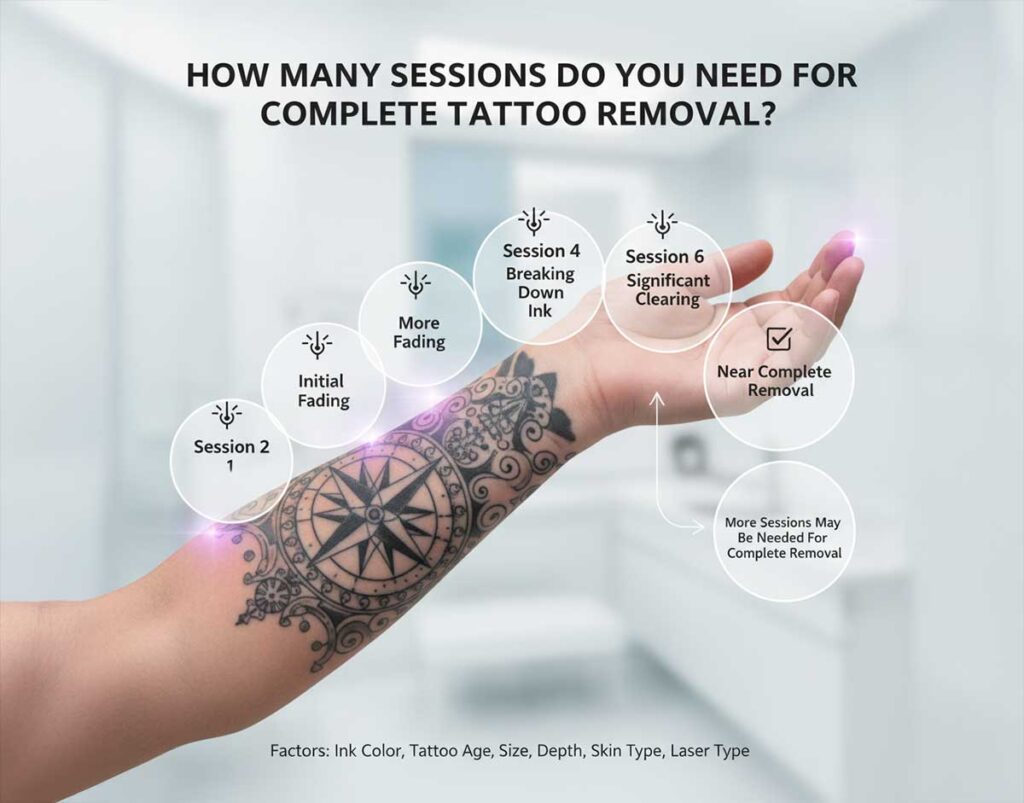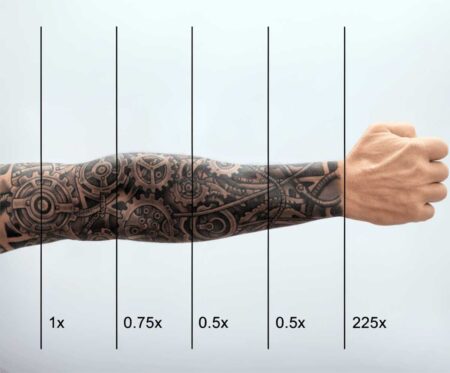Removing an unwanted tattoo is no longer a mystery, thanks to the advancements in laser technology. The process is safer, faster, and more effective than ever. But one of the most common questions people ask before starting treatment is: “How many sessions will it take to remove my tattoo completely?”
The answer depends on several personal and technical factors. In this guide, we’ll break down how tattoo removal works, what affects the number of sessions, and how to achieve the best possible results safely.
Understanding How Laser Tattoo Removal Works
Laser tattoo removal works by using concentrated light beams that target and break down tattoo ink particles beneath the skin. These ink particles are then gradually eliminated by the body’s natural immune system.
Modern devices like Q-switched Nd:YAG and PicoSure lasers operate at multiple wavelengths to remove a wide range of ink colors, from black and blue to green and red, with high precision and minimal skin damage.
Unlike older methods such as dermabrasion or surgical excision, laser tattoo removal is non-invasive and customizable, meaning each treatment is tailored to your skin tone, tattoo color, and sensitivity.
Average Number of Tattoo Removal Sessions
In most cases, tattoo removal requires between 6 to 10 laser sessions spaced 4 to 8 weeks apart.
However, this is just an average, some patients may need fewer treatments, while others may require more depending on their tattoo’s characteristics.
Typical Session Timeline
| Tattoo Type | Average Sessions | Estimated Duration |
| Small black tattoo (1–2 colors) | 4–6 sessions | 3–5 months |
| Medium multi-colored tattoo | 6–10 sessions | 6–12 months |
| Large or dense tattoos | 10–15+ sessions | 9–18 months |
| Amateur / homemade tattoo | 3–5 sessions | 2–4 months |
The Fitzpatrick skin type, ink density, and location on the body all influence the total number of sessions required.
Factors That Affect How Many Sessions You’ll Need
1. Tattoo Size and Ink Density
Larger tattoos with thick, layered ink take longer to clear.
Fine-line or shaded tattoos, on the other hand, fade faster because the pigment is distributed more thinly under the skin.
2. Tattoo Color and Ink Composition
Dark inks like black and navy blue absorb laser energy most efficiently, making them easier to remove.
In contrast, bright pigments like green, yellow, or turquoise may require specialized wavelengths or additional sessions to fade completely.
3. Skin Type and Tone
Your natural skin tone plays a crucial role in selecting the correct laser wavelength. For example, darker skin types need gentler energy settings to prevent pigment changes or irritation, which can extend the treatment timeline slightly.
4. Laser Technology Used
The type of laser determines efficiency:
- Q-switched lasers: The long-time standard, effective but slower.
- PicoSure / PicoWay lasers: Newer-generation devices that use ultra-short bursts to shatter ink faster and require fewer sessions.
5. Tattoo Location
Areas with good blood circulation (such as the upper back, chest, or arms) heal faster. Extremities like ankles or wrists may take longer because of reduced lymphatic drainage.
6. Immune System and Lifestyle
The body’s immune system is responsible for clearing fragmented ink particles. Healthy habits such as hydration, not smoking, and regular exercise can improve blood flow and speed up ink elimination.
What Happens During Each Session
Each session typically lasts 15 to 45 minutes, depending on tattoo size and the number of passes made with the laser.
- Preparation: The area is cleaned, and a topical numbing cream may be applied 30–45 minutes before to minimize discomfort.
- Laser Treatment: Short pulses of light target the pigment. You may feel mild snapping sensations, often compared to the snap of a rubber band.
- Cooling and Recovery: Ice packs and soothing ointments reduce redness or swelling.
- Aftercare: You’ll be advised to keep the area clean, avoid direct sunlight, and use SPF regularly to prevent pigmentation.
Can You Speed Up the Process?
While it’s tempting to schedule back-to-back sessions, it’s essential to allow the skin time to heal and the immune system to process the fragmented ink. Experts recommend a 4–8 week gap between sessions to prevent scarring and optimize pigment clearance.
Pro Tips for Better Results
- Stay hydrated: Helps lymphatic drainage.
- Avoid tanning: Reduces risk of hyperpigmentation.
- Don’t pick scabs: Let the skin regenerate naturally.
- Boost immunity: Balanced nutrition supports faster recovery.
Does More Sessions Mean Better Results?
Not always. Quality matters more than quantity. Over-treating the same area too soon can lead to inflammation or minor scarring. Following your dermatologist’s schedule ensures optimal healing and gradual fading.
If a tattoo still appears faintly after 10 sessions, a professional may advise combination therapy, for example, using Pico laser + fractional resurfacing for the final pigment layer.
Possible Side Effects and Safety
When performed by trained specialists, laser tattoo removal is safe and rarely causes permanent side effects. Temporary redness, mild swelling, or scabbing are common and usually subside within a few days.
Be cautious of unlicensed clinics offering “quick removal” or high-power lasers. Improper treatment can lead to burns, pigment changes, or scarring. Always ensure your practitioner is certified in laser dermatology or aesthetic medicine.
For safe and verified options, explore specialists listed on Tabeebo’s Tattoo Removal Experts.
The Bottom Line
There’s no one-size-fits-all answer to “How many sessions do you need for tattoo removal?”, but understanding the key factors helps you set realistic expectations.
- Small, dark tattoos: 4–6 sessions
- Larger, multi-colored tattoos: 8–12 sessions
- Modern laser devices: Can reduce total sessions by up to 30%
By following a personalized plan and choosing a reputable provider, you can achieve clearer skin safely, without unnecessary risks or unrealistic promises.
References
- American Society for Dermatologic Surgery. Laser \Tattoo Removal: What to Expect.
- American Academy of Dermatology (AAD). Tattoo Removal FAQs.
- Mayo Clinic. Laser Tattoo Removal Procedures.
- Healthline. Tattoo Removal: How It Works and What to Expect.






